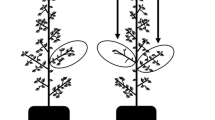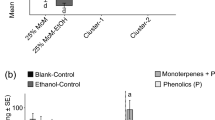Abstract
Recent studies have identified a small number of individual eastern hemlock trees that demonstrate relative resistance to the introduced sap-feeding insect, the hemlock woolly adelgid. Using gas chromatography, we compared concentrations of twenty-two terpenoids in susceptible and relatively resistant trees, both in the forest and in propagated cuttings in a common-garden setting. Terpenoid concentrations were higher in twig tissue of resistant versus susceptible trees, across six sampling dates and at both sites. These changes may be particularly important because the hemlock woolly adelgid feeds on twig tissue. Because the common-garden cuttings were free of herbivores, the higher terpenoid concentrations are interpreted as a constitutive defense. Increased levels of monoterpenes and sesquiterpenes imply an overall increase in the input of carbon precursors to both terpenoid synthesis pathways.

Similar content being viewed by others
References
Adams RP (2009) Identification of essential oil components by gas chromatography / Quadrupole Mass Spectroscopy. Allured Press, Illinois
Bentz S, Riedel L, Pooler M, Townsend A (2002) Hybridization and self-compatibility in controlled pollinations of eastern North American and Asian hemlock (Tsuga) species. J Arboric 28:200–205
Bernard-Dagan C, Pauly G, Marpeau A, Gleizes M, Carde JP, Baradat P (1982) Control and compartmentation of terpene biosynthesis in leaves of Pinus pinaster. Physiol Veg 20:775–795
Broeckling CD, Salom SM (2003) Volatile emissions of eastern hemlock, Tsuga canadensis, and the influence of hemlock woolly adelgid. Phytochemistry 62:175–180
Caswell TR, Casagrande R, Maynard B, Preisser EL (2008) Production and evaluation of eastern hemlocks potentially resistant to the hemlock woolly adelgid. In: Onken B, Reardon R (eds) 4th Symposium on hemlock woolly adelgid in the eastern United States. USDA Forest Service, Hartford, pp 124–134
Domec JC, Rivera LN, King JS, Pezlen I, Hain F, Smith B, Frampton J (2013) Hemlock woolly adelgid (Adelges tsugae) infestation affects water and carbon relations of eastern hemlock (Tsuga canadensis) and Carolina hemlock (Tsuga caroliniana). New Phytol 199:452–463
Franceschi VR, Krokene P, Christiansen E, Krekling T (2005) Anatomical and chemical defenses of conifer bark against bark beetles and other pests. New Phytol 167:353–376
Gomez S, Orians CM, Preisser EL (2012) Exotic herbivores on a shared native host: tissue quality after individual, simultaneous, and sequential attack. Oecologia 169:1015–1024
Gonda-King L, Radville L, Preisser EL (2012) False ring formation in eastern hemlock branches: impacts of hemlock woolly adelgid and elongate hemlock scale. Environ Entomol 41:523–531
Herms DA, Mattson WJ (1992) The dilemma of plants: to grow or defend. Q Rev Biol 67:283–335
Ingwell LL, Preisser EL (2011) Using citizen science programs to identify host resistance in pest-invaded forests. Cons Biol 25:182–188
Ingwell LL, Brady J, Fitzpatrick M, Maynard B, Casagrande R, Preisser EL (2009) Intraspecific variation in Tsuga canadensis foliar chemistry. Northeast Nat 16:585–594
Lagalante AF, Montgomery ME (2003) Analysis of terpenoids from hemlock (Tsuga) species by solid-phase microextraction/gas chromatography/ion-trap mass spectrometry. J Agric Food Chem 51:2115–2120
Lagalante AF, Montgomery ME, Calvosa FC, Mirzabeigi MN (2007) Characterization of terpenoid volatiles from cultivars of eastern hemlock (Tsuga canadensis). J Agric Food Chem 55:10850–10856
Mattson WJ (1986) Protecting future forests from insects. In: Crowley JJ (ed) 1986 Yearbook of agriculture: Research for tomorrow. USDA, Washington, D.C., pp 225–228
McClure MS (1989) Evidence of a polymorphic life cycle in the hemlock woolly adelgid, Adelges tsugae (Homoptera: Adelgidae). Ann Entomol Soc Am 82:50–54
McClure MS (1991) Density-dependent feedback and population-cycles in Adelges tsugae (Homoptera: Adelgidae) on Tsuga canadensis. Environ Entomol 20:258–264
McCune B, Grace JB, Urban DL (2002) Analysis of ecological communities. MjM software design, Gleneden Beach, Oregon, USA
Montgomery ME, Bentz SE, Olsen RT (2009) Evaluation of hemlock (Tsuga) species and hybrids for resistance to Adelges tsugae (Hemiptera: Adelgidae) using artificial infestation. J Econ Entomol 102:1247–1254
Orwig DA, Foster DR (1998) Forest response to the introduced hemlock woolly adelgid in southern New England, USA. J Torrey Bot Soc 125:60–73
Orwig DA, Foster DR, Mausel D (2002) Landscape patterns of hemlock decline in New England due to the introduced hemlock woolly adelgid. J Biogeogr 29:1475–1488
Oten KLF, Bauchan GR, Frampton J, Hain FP (2012) Biophysical characteristics of the stem and petiole surface of six hemlock (Tsuga) species and a hybrid: implications for resistance to Adelges tsugae. Botany 90:1170–1178
Paradis A (2011) Population dynamics of the hemlock woolly adelgid (Hemiptera: Adelgidae). University of Massachusetts, Amherst, MA, Dissertation
Pezet J, Elkinton J, Gomez S, McKenzie EA, Lavine M, Preisser EL (2013) Hemlock woolly adelgid and elongate hemlock scale induce changes in foliar and twig volatiles of eastern hemlock. J Chem Ecol 39(1090):1100
R Development Core Team (2012) R 2.15.2: a language and environment for statistical computing. R Foundation for Statistical Computing, Vienna, Austria. http://www.R-project.org. Accessed 12 May 2013.
Radville L, Chaves A, Preisser EL (2011) Variation in plant defense against invasive herbivores: evidence for a hypersensitive response in eastern hemlocks (Tsuga canadensis). J Chem Ecol 37:592–597
Reis P, Dix ME, Ielmini M, Thomas D (2004) National strategy and implementation plan for invasive species management. USDA Forest Service, Washington, D.C
Schoettle AW, Klutsch JG, Sniezko RA (2012) Integrating regeneration, genetic resistance, and timing of intervention for the long-term sustainability of ecosystems challenged by non-native pests – a novel proactive approach. In: Proceedings of the 4th International Workshop on Genetics of Host-Parasite Interactions in Forestry: General Technical Report. pp 112–123
Stein SE (2005) NIST Standard Reference Database 1a.NIST/EPA/NIH Mass Spectral Database (NIST05) and NIST Mass Spectral Search Program (NIST05s; Version 2.0 g)
Vlot AC, Dempsey DA, Klessig DF (2009) Salicylic acid, a multifaceted hormone to combat disease. Annu Rev Phytopathol 47:177–206
Wu J, Baldwin IT (2010) New insights into plant responses to the attack from insect herbivores. Annu Rev Genet 44:1–24
Young R, Shields K, Berlyn G (1995) Hemlock woolly adelgid (Homoptera: Adelgidae): stylet bundle insertion and feeding sites. Ann Entomol Soc Am 88:827–835
Acknowledgments
We gratefully acknowledge Joshua Pezet for developing the chemical methods and Elwood Roberts for propagation of resistant trees. This work is supported by the United States Department of Agriculture National Institute of Food and Agriculture grant #2010–03710 to ELP and JSE, and RI-AES Hatch Grant RI00HI-4004 to ELP and RAC. Access to the New Jersey forest sites was permitted through the New Jersey Department of Environmental Protection, Division of Fish & Wildlife and the Delaware Water Gap National Recreation Area, National Parks Service.
Author information
Authors and Affiliations
Corresponding author
Electronic supplementary material
Below is the link to the electronic supplementary material.
ESM 1
(PDF 39 kb)
Rights and permissions
About this article
Cite this article
McKenzie, E.A., Elkinton, J.S., Casagrande, R.A. et al. Terpene Chemistry of Eastern Hemlocks Resistant to Hemlock Woolly Adelgid. J Chem Ecol 40, 1003–1012 (2014). https://doi.org/10.1007/s10886-014-0495-0
Received:
Revised:
Accepted:
Published:
Issue Date:
DOI: https://doi.org/10.1007/s10886-014-0495-0




